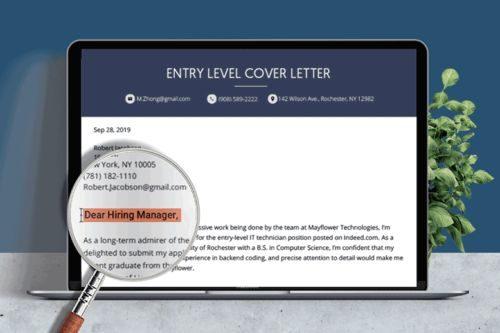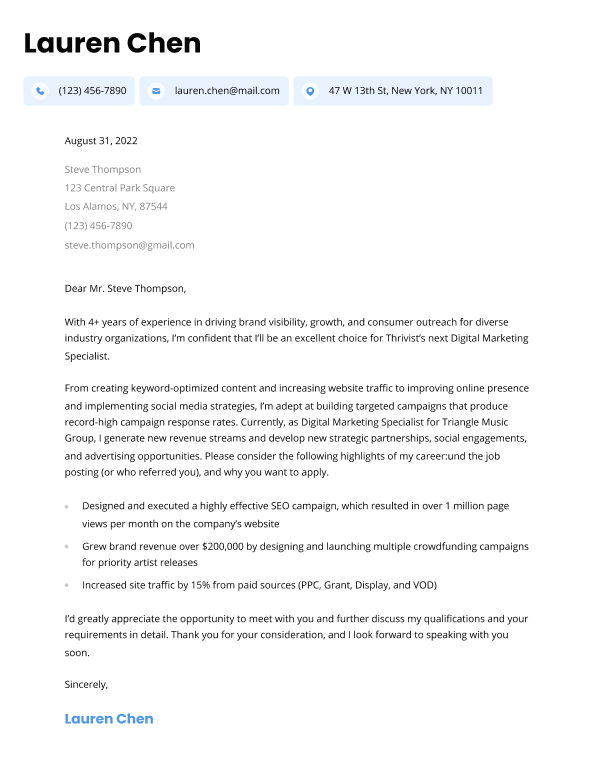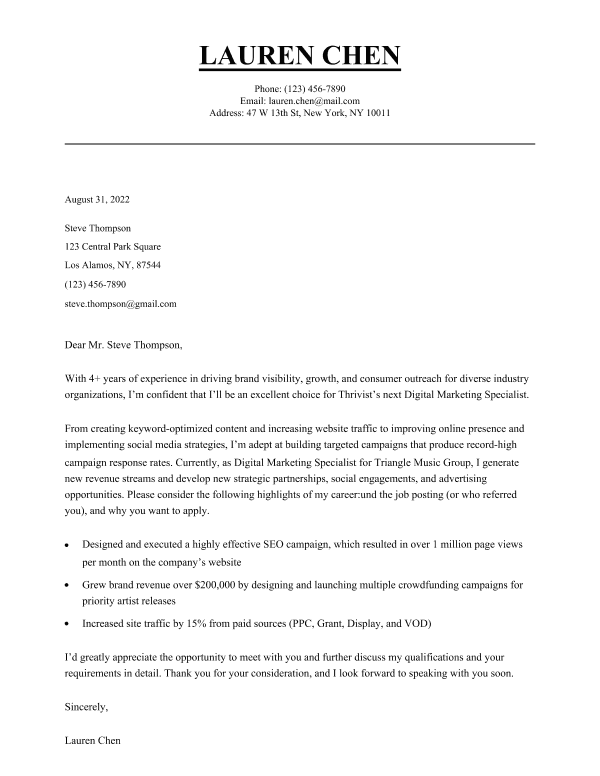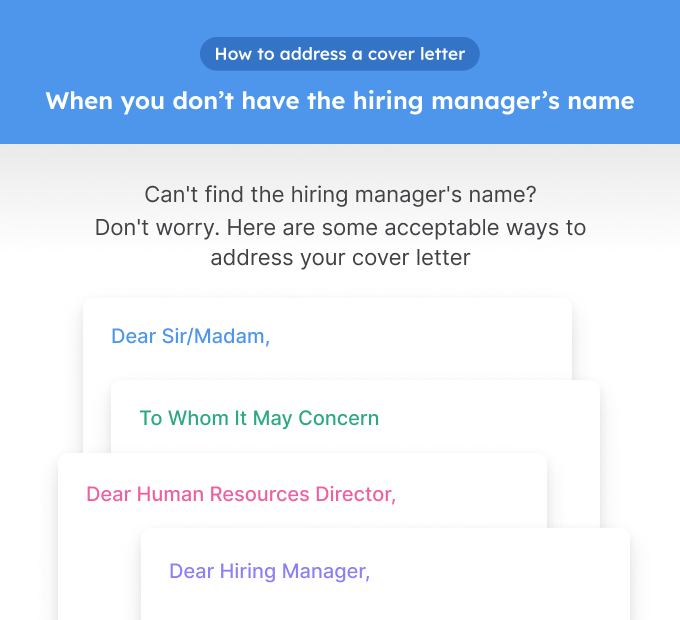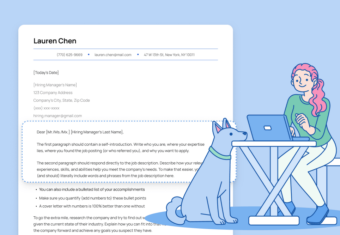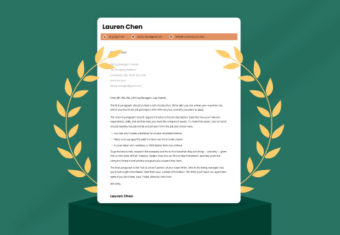Knowing how to address a cover letter properly is the first step toward starting your cover letter.
Not only that, but finding out the right person to address shows initiative and that you’ve researched the position thoroughly. Take time to find out who to address a cover letter to and how to address them appropriately so you can make a positive first impression on the hiring manager at your target company.
Our free-to-use cover letter builder can make you a cover letter in as little as 5 minutes. Just pick the template you want, and our software will format everything for you.
Who to address a cover letter to
You should address a cover letter to the hiring manager of the job you’re applying for, or the HR manager of the company. A basic cover letter salutation (or greeting) uses the hiring manager’s first and last name and includes a “Mr.”, “Ms.”, or other relevant professional title before their name.
But you’ll often find yourself in situations where there’s no personal contact information in the job post or if you’re cold emailing for a job, you’re unsure of who to contact. Either way, you’ll need to address your letter the right way, and addressing the hiring manager is the safest way to do so.

Dread writing cover letters? Read our guide to learn how to write a great cover letter that convinces hiring managers you’re the ideal person for the job.
How to find out who to address a cover letter to
In many cases, the hiring manager’s name will be mentioned in the job description. If you can’t find the hiring manager’s name in the job description, make the effort to find their name elsewhere. It’s worth the extra work, so use the following sources to help you find the hiring manager’s name:
- The company website: See if you can locate the hiring manager on the “About Us” or “Company Directory” page of the company’s website.
- LinkedIn: Browse the company’s LinkedIn page and use filters such as position title, location, and personal names to find out who heads the hiring team.
- Google search: A targeted Google search can help you uncover the name of the hiring manager. Simply insert the company website and relevant title into Google in the following format: site:resumegenius.com “position title”
- Contact the company: If you’re still unable to find the hiring manager’s name, call or email the company and ask for the contact person’s name (and direct email address if you don’t have it already). Explain that you’re applying for a position and you’d like to address your cover letter to someone responsible for filling that position.
Addressing your cover letter to the hiring manager directly allows you to quickly establish a personal connection and shows you’ve done your research. A cover letter addressed to the right person and tailored to the company you’re applying for is more likely to get noticed than a generic cover letter sent to multiple companies.
This is why it’s so crucial to address a cover letter the right way.
If you decide to use email, you can approach someone within the same department you’re interested in and ask for the hiring manager’s contact information.
How to address a cover letter without a name
If you’ve exhausted all your options and still can’t find the hiring manager’s name, or you’re not positive it’s the right name and don’t want to risk addressing the wrong person, it’s better to be on the safe side.
So don’t worry, there are plenty of options you can try if the hiring manager’s name is unknown. Here are the most common ways to address a cover letter without a name:
- To Whom It May Concern
- Dear Human Resources Director
- Dear Hiring Manager
- Dear Recruitment Manager
Additionally, if you want to add a personal touch, address your cover letter to your prospective department or manager. For example, “Dear Customer Service Department,”.
If you download a cover letter sample online, make sure you personalize the greeting. Many samples use “To Whom It May Concern” or “Dear Sir or Madam” which is considered old-fashioned and generic. While it’s unlikely that any employer will hold your cover letter salutation against you, being specific in your cover letter address is still the best policy.
How to address a cover letter with a name
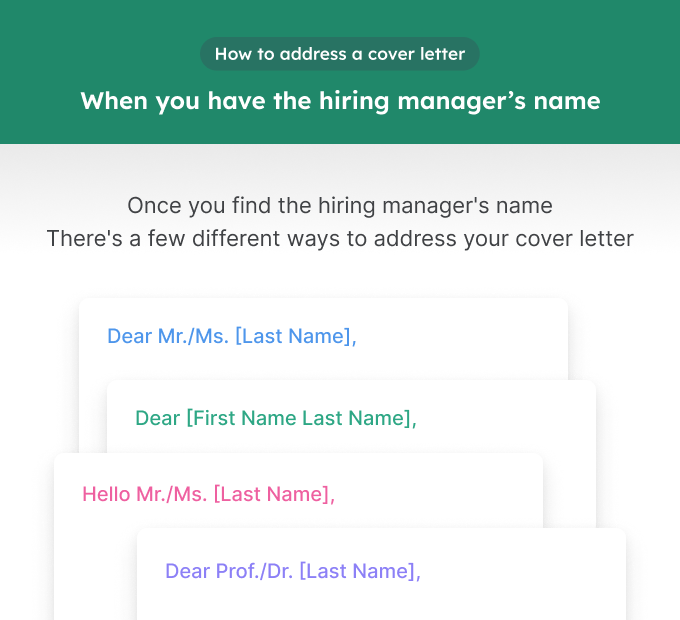
Even when you have the hiring manager’s name, there are still a few different ways to address your cover letter.
Use the right salutation
First thing’s first: you need to use the proper salutation. Usually, “Dear” followed by the hiring manager’s name is perfect because it’s traditional and professional.
However, “Hello” is also acceptable if you’re applying to a job with a casual office culture or you know the hiring manager personally.
Not including a salutation and just starting your cover letter with the hiring manager’s first and last name is also acceptable.
Use their academic, professional, or gendered title
In some cases, it might be unclear what title to use when addressing the hiring manager.
If the hiring manager has a gender-neutral name, it’s best not to assume their gender and risk making a mistake. In this situation, simply avoid gender-specific titles such as “Mr.” and “Ms.” in your greeting.
Instead, do either of the following to make your cover letter salutation gender-neutral:
- Write out their first and last names in full (e.g. Jordan Reeves)
- Use the gender-neutral pronoun “Mx.“, in the case that the hiring manager explicitly wants to be addressed this way
An easy way to confirm the gender of the hiring manager is by doing a quick search for their name on LinkedIn. In some cases, hiring managers list their gender pronouns at the top of their profile to clarify.
When you address a cover letter to a hiring manager with a professional or academic title (like Doctor or Professor), include their title in your salutation. You can write out the full title or use an abbreviation. For example, “Reverend” and “Rev.” are both fine.
Here are some examples of a few different ways to address your cover letter:
- Dear Sam Jones,
- Dear Mx. Lopez,
- Dear Ms. Patel,
- Dear Prof. Tsai,
If you’re addressing your cover letter with “Dear” you should always use the hiring manager’s last name.
The only time it’s acceptable to address the hiring manager with only their first name (for example, “Dear Mollie,”) is if you’re writing a cover letter for an internal position or promotion in the same company, and you already know the hiring manager.
Click to rate this article
4.7 Average rating


